The Science and Technology Directorate (S&T) recently hosted its annual Silicon Valley Innovation Program (SVIP) Demo Week, bringing together federal government and startup communities to exhibit new technologies, talk through ideas and identify opportunities for future collaboration.
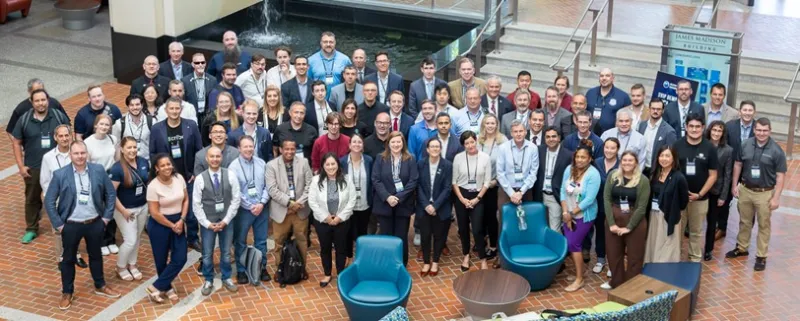
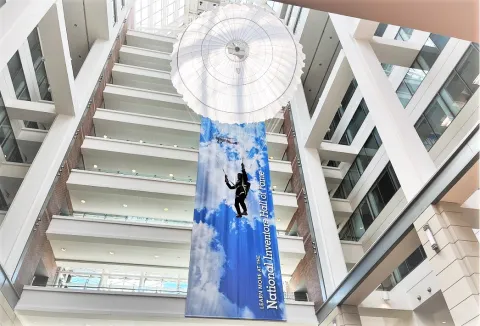
Inventions were center stage at the Science and Technology Directorate’s (S&T) annual Silicon Valley Innovation Program (SVIP) Demo Week in May. Hosted at the United States Patent and Trademark Office (USPTO) Headquarters in Alexandria, VA, the home of USPTO’s National Inventors Hall of Fame, the spirit of innovation was celebrated over two days of exposition, demonstration, and thought leadership.
SVIP reshapes how government, entrepreneurs, and industry work together to strengthen national security through cutting-edge technology solutions, and Demo Week allows S&T’s startup partners to showcase their current crop of new designs to both public and private sector audiences. Ultimately, the event serves as a space where the innovation community—both nationally and internationally—can connect and find ways to harness the commercial research and development (R&D) ecosystem for technologies with government applications and accelerate technology transition-to-market.
“In this room, we have disruptors, dreamers, and even the occasional tech bro. It’s like the ultimate mashup of Silicon Valley meets Capitol Hill,” said SVIP Managing Director Melissa Oh. “It’s a place for government and startups to converge in pursuit of innovation and progress.”
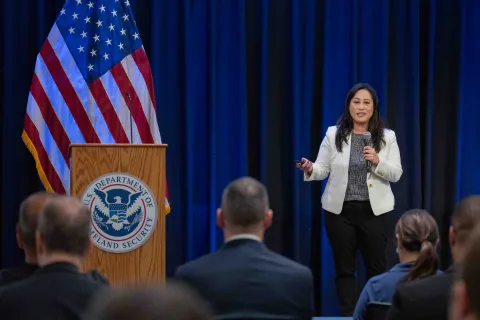
Oh kicked off the event by explaining how the best innovations happen when diverse perspectives collide. The Apollo 11 moon landing is proof of that, she said. And crab traps actually inspired NASA’s model for the craft’s landing legs—a nod to the inventiveness that can take place in building government technology. Similarly, one of SVIP’s most successful R&D efforts—Maritime Object Tracking Technology (MOTT), used for accurately marking and monitoring objects in the water for recovery—started out as a lobster crate equipped with a dog collar.
“We are seeing a tidal wave of dual-use technologies, where commercial tech meets national security, and it’s propelling economic growth and improving public services,” Oh said.
SVIP is often an entry point for startups that might not have otherwise worked with government. For instance, Birmingham, AL-based SVIP startup Analytical AI was recently awarded a $20 million contract with the Department of Homeland Security for its image-based artificial intelligence (AI), used for object recognition screening at airports. The development of those algorithms also enabled the company to work with the U.S. Army to outfit the next generation of mine-resistant ambush resistant vehicles with AI-powered ability to screen for possible IEDs. Another SVIP startup from Brisbane, Australia, female-founded FloodMapp, was awarded a flood modeling contract from the City of Boston in April to provide real-time flood monitoring. This technology will help Boston’s Emergency Operations Center target areas for evacuation and flood mitigation, support ongoing emergency response efforts with real-time mapping, and understand maximum flooding extent in order to distribute disaster relief and streamline damage assessment.
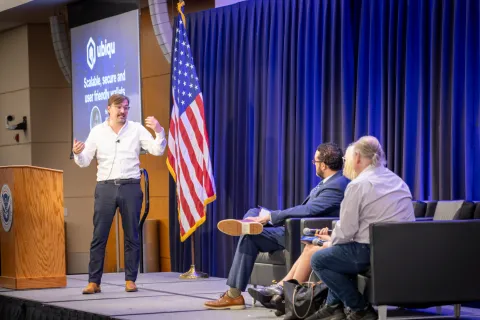
S&T’s work with these startup companies is force-multiplying; ultimately an investment in cutting-edge capabilities that are not only commercially sustainable, but that also meet the immediate needs of the Department of Homeland Security’s (DHS) operational components. That is why events like Demo Week are so critical—the feedback given not only helps to shape the course of the R&D, but also helps to expand horizons and imagine new use cases.
This year, 36 SVIP startups, including Analytical AI and FloodMapp, presented their technologies in a new “Shark Tank” style format, where a panel of experts asked them questions live on-stage in front of an audience. The “sharks” brought a blend of operational, technical, and business expertise to challenge the companies and help the audience of startups, federal employees, and prospective financiers better understand the technologies to help identify potential collaborative opportunities. Separate expert panels judged different topic areas, including sensors, healthtech, computer vision, data analytics, cybersecurity, digital credentials, and digital wallets. The sharks asked probing questions to ensure participants had anticipated a pathway to commercialization and the potential challenges.

Beyond the pitch sessions, additional Demo Week panels featured thought leadership discussions among DHS experts and provided insights to startups on how to engage with the public sector. In one panel, Partnership Pathways for DHS R&D and Commercialization, startups heard from representatives from other Office of Industry Partnership (OIP) programs about a variety of ways to engage with the Directorate, including through prize competitions, the Homeland Security Startup Studio, and the DHS Small Business Innovation Research (SBIR) program.
“We’re hyper-focused on ensuring that we have a portfolio of programs that are available to innovators of all sizes. So, we don’t want to just do all small businesses, we don’t want just all large businesses. We’re really focused on diversifying the people that we work with, the companies we work with, bringing new ideas to the Department, and working with our end users to get new technologies into their hands. And developing a commercial market for Homeland Security technologies,” said Megan Mahle, director of OIP.
As part of the AI-focused Empowering the Technologists Who are Securing Our Future panel, DHS Chief Technology Officer David Larrimore lauded the startups as the ones “building products people need, not just what will sell.” Another panelist, Graham Dufault, general counsel for the nonprofit ACT|The App Association, said he is really impressed with SVIP for its public-private engagement model and hinted that DHS is further along than other federal agencies in developing these types of programs.
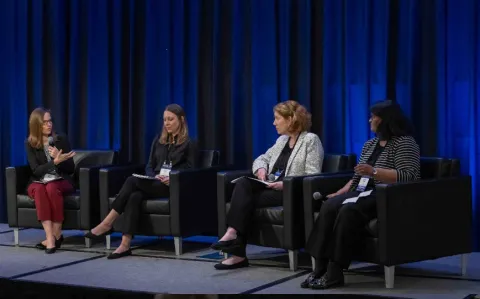
“One of the really important things that SVIP has done was to build bridges to companies that may not necessarily have a federal client base in mind but that have a customer base that they’re looking to serve,” Dufault said. “They’re developing a software tool or device that’s going to be really amazing for this use case but also, with a couple of tweaks, would be incredible put into service as something for [DHS].”
During her keynote speech, Jody M. Hardin, executive director of U.S. Customs and Border Protection’s Office of Field Operations Innovation and Strategy Directorate, welcomed this, saying that “as quickly as technology is advancing, we also need insights from experts like all of you on how technology can be used by our adversaries and help us anticipate and close those gaps.”
Oh reminded the audience that the goal of the event is to create a “dynamic space for collaboration, discussion and discovery.” When she asked for a show of hands of how many had connected with someone during Demo Week that could become a potential collaborator, hands shot up across the room.

“This is what I’m here for, this is what I want to happen,” she said. “Holding this event in Washington, DC, is fantastic. We’re bringing the startups and the agencies together, and I think a lot of magic can come from it.”
To learn more about SVIP’s 2024 Demo Week and access recordings, please visit the Demo Week Event Page. For related media inquiries, contact STMedia@hq.dhs.gov.
